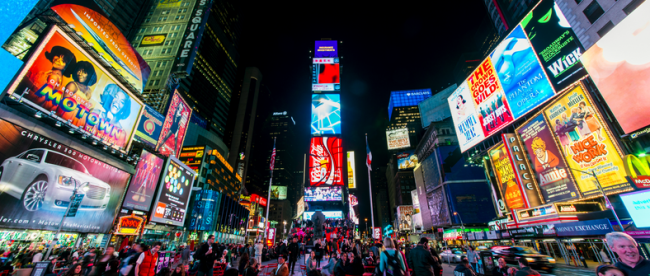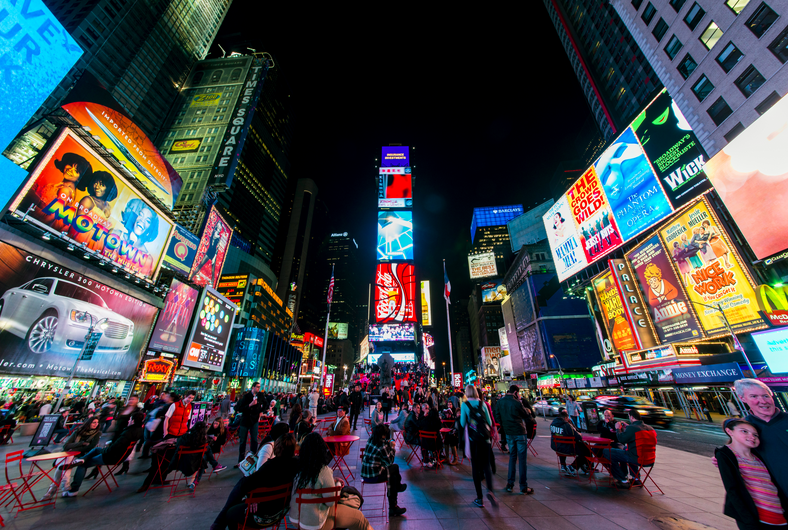The Law That May Accidentally Break Times Square


That, pictured above, is Times Square, the tourist trap center of New York City. You can tell because there are billboards the size of small aircraft plastered on virtually every vertical square inch. The signs, collectively, are iconic. The billboards define the space, perhaps moreso than the cross-streets (Broadway and Seventh Avenue) or the newspaper (the New York Times) after which the square is named. Times Square wouldn’t be Times Square without the billboards.
Which is unfortunate, because those billboards are probably illegal.
The problem starts back in 1965, when the U.S. federal government passed something called the “Highway Beautification Act.” It regulated “outdoor advertising” — billboards — because they were distracting and ugly. Really. The text of the law states that “Congress hereby finds and declares that the erection and maintenance of outdoor advertising [. . .] in areas adjacent to the Interstate System [ . . . ] should be controlled in order to protect the public investment in such highways, to promote the safety and recreational value of public travel, and to preserve natural beauty.” One of the subsequent “controls” regulated the size of the billboards; according to Marketplace, signs can be no larger than 1,200 square feet. Many, many of the ones in Times Square are larger than that.
But Seventh Avenue and Broadway aren’t part of the “Interstate System” or “highways.” Rather, they’re local roadways which are classified as something called “urban principal arterials.” The official definition of the term, per the New York Department of Transportation (FC 14 if you click that link), describes the roads that encapsulate Times Square: urban principal arterials “serve the major centers of activity of a metropolitan area, the highest traffic volume corridors” and “carry a high proportion of the total urban area travel on a minimum mileage.” So Times Square is OK — Seventh and Broadway aren’t covered by the Highway Beautification Act.
Or weren’t, until 2012.
In May of that year, the U.S. government passed a law — a massive law — designed to “transform” how the nation handles its roads. Titled “Moving Ahead for Progress in the 21st Century” or MAP-21 for short, the law is so important that the U.S. Department of Transportation (DOT) has at least three websites (1, 2, 3) dedicated to it. MAP-21 promises lots of federal money for investment in roads here, there, and everywhere. It starts by defining the roads that it applies to — and by redefining what a highway is. If you go to section 1104, subsection 103(a)(2)(B) of MAP-21 (click here and scroll, or click here for a highlighted screenshot of the relevant text), you’ll see that MAP-21 expanded the “National Highway System” (in 1965, called the “Interstate System”) to include “urban principal arterial routes” — which includes the roads which make up Times Square. Uh oh.
Of course, as Capital New York points out, the goal behind the Highway Beautification Act wasn’t to make Times Square look like a bunch of boring office buildings (although that would be an improvement), but to protect the natural scenery found on more rural roadways. And while there were initial reports that the DOT was going to push the issue anyway, those, thankfully, appear to be untrue. According to Business Insider, as of May 2015, the DOT has denied asking New York to take down the signs. But more recently, per the above-linked Marketplace report, there’s been reason to believe that the ubiquitous ads are indeed at risk: “city, state and federal officials say they’re looking for a solution to keep the billboards.” (They’ll probably find one.)
 Bonus Fact: What if a landlord wanted to comply with MAP-21 and remove their billboards? It turns out, they may not be able to. According to the Wall Street Journal, New York City has specifically zoned the Times Square area to require the billboards. For buildings in the zone, per the law, “there shall be a minimum of one ‘illuminated sign’ with a ‘surface area’ of not less than 1,000 square feet for each 50 linear feet, or part thereof, of ‘street’ frontage.” That’s often smaller than the max size allowed by MAP-21, but understandably, many building well exceeded that minimum — just to stay on the safe side.
Bonus Fact: What if a landlord wanted to comply with MAP-21 and remove their billboards? It turns out, they may not be able to. According to the Wall Street Journal, New York City has specifically zoned the Times Square area to require the billboards. For buildings in the zone, per the law, “there shall be a minimum of one ‘illuminated sign’ with a ‘surface area’ of not less than 1,000 square feet for each 50 linear feet, or part thereof, of ‘street’ frontage.” That’s often smaller than the max size allowed by MAP-21, but understandably, many building well exceeded that minimum — just to stay on the safe side.
From the Archives: Signs of the Times: The Times Square office building that’s empty — intentionally.
Take the Quiz: Of the streets listed in this quiz, can you identify the ones which are in Manhattan — and those which aren’t?
Related: “The Devil’s Playground: A Century of Pleasure and Profit in Times Square” by James Traub. 4.4 stars on 13 reviews.
